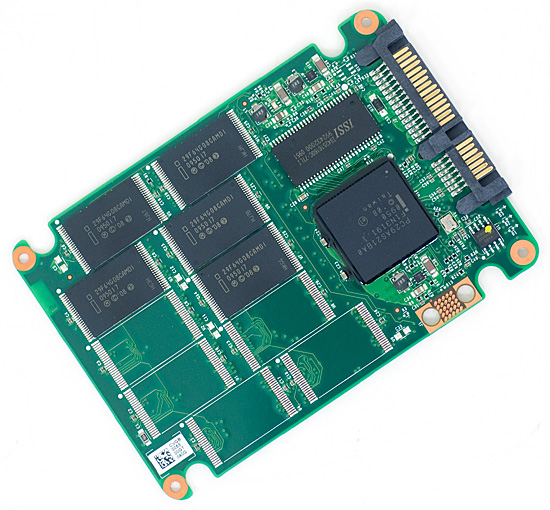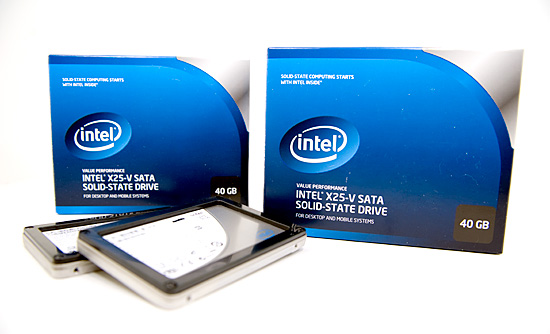Intel X25-V in RAID-0: Faster than X25-M G2 for $250?
by Anand Lal Shimpi on March 29, 2010 8:59 PM ESTNot to sound like a broken record, but with the exception of OCZ's Vertex LE, not much has changed in the SSD market over the past couple of years. Intel still seems like the safest bet, and these days they're even offering a pretty compelling value.
The 80GB X25-M G2 is finally selling for reasonable prices and earlier this month Intel launched its first value SSD: the X25-V. Priced at $125, the X25-V gives you much of the performance of the X25-M but at a lower cost and capacity point. It's a great way to safely transition to an SSD.

Intel's X25-V uses the same controller as the X25-M G2, but with half the NAND and thus half the channels
For months now you all have been asking me to tackle the topic of RAIDing SSDs. I've been cautious about doing so for a number of reasons:
1) There is currently no way to pass the TRIM instruction to a drive that is a member of a RAID array. Intel's latest RAID drivers allow you to TRIM non-member RAID disks, but not an SSD in a RAID array.
2) Giving up TRIM support means that you need a fairly resilient SSD, one whose performance will not degrade tremendously over time. On the bright side, with the exception of the newer SandForce controllers, I'm not sure we've seen a controller as resilient as Intel's.
A couple of weeks ago I published some early results of Intel's X25-V SSD. But I was holding out on you, I actually had two:

Using the same Intel X58 testbed I've been using for all of my SSD tests, I created a 74.5GB RAID-0 array out of the two drives and quickly ran them through almost all of our benchmarks. At a total cost of $250, a pair of X25-Vs will set you back more than a single 80GB X25-M and you do give up TRIM, but is the performance worth it?
The Test
| AnandTech SSD Testbed | ||||
| Product | ||||
| CPU |
Intel Core i7 965 running at 3.2GHz (Turbo & EIST Disabled)
|
|||
| Motherboard |
Intel DX58SO
|
|||
| Chipset |
Intel X58 + Marvell SATA 6Gbps PCIe
|
|||
| Chipset Drivers |
Intel 9.1.1.1015 + Intel IMSM 8.9
|
|||
| Memory |
Qimonda DDR3-1333 4 x 1GB (7-7-7-20)
|
|||
| Video Card |
eVGA GeForce GTX 285
|
|||
| Video Drivers |
NVIDIA ForceWare 190.38 64-bit
|
|||
| Desktop Resolution |
1920 x 1200
|
|||
| OS |
Windows 7 x64
|
|||










87 Comments
View All Comments
morphin1 - Saturday, April 3, 2010 - link
Thank you a lot Anand for the reply and clearing that up for me.The Sony Vaio Z has samsung MMCRE28G drives(2*64GB).
I am holding my buying decision on your recomendation. What say you? Will the above drives be rendered useless overtime with Trim?
Thanks you a lot for your time.
I have been reading AT for over 2years now and love the indepth reviews you guys do as opposed to other sites.
Love this site.
Cheers
morphin1 - Saturday, April 3, 2010 - link
How will the samsung drive fare without TRIM.I wrote incorrectly when i said With TRIM.
Chloiber - Sunday, April 4, 2010 - link
What's the QD of the random read/write tests (did I miss it?)?AnalyticalGuy3 - Wednesday, April 7, 2010 - link
Suppose I have four X25V's in RAID 0 using the Intel ICH10. Two questions:
1) Just to confirm my understanding, a random read request smaller than the stripe size should only access one member of the array, correct?
2) Suppose the queue contains four random read requests smaller than the stripe size. And suppose I'm really lucky -- each random read request happens to tap a different member of the array. Is the ICH10 smart enough to dispatch all four random read requests in parallel?
boostcraver - Tuesday, April 13, 2010 - link
Anand,I'm sure I read this article thoroughly but I didn't see exactly what the RAID configuration was - whether onboard raid, dynamic disks in Windows, or a dedicated RAID add-in card.
Once that is explained, it'd be great if we could get a benchmark comparison of these different RAID technologies. Something to justify the simplicity of using Windows dynamic disks for raid0 / raid1 configuration, or to spend the extra bucks on a SAS/SATA raid card. Since everyone has been supporting RAID0 for the best performance, we should understand exactly the options at hand.
Thanks for the great articles.
- boostcraver
Shin0chan - Friday, June 18, 2010 - link
"A standard 80GB X25-M wouldn't be this bad off, the X25-V gets extra penalized by having such a limited capacity to begin with. You can see that the drive is attempting to write at full speed but gets brought down to nearly 0MB/s as it has to constantly clean dirty blocks. Constant TRIMing would never let the drive get into this state. It's worth mentioning that a desktop usage pattern shouldn't get this happen either. Another set of sequential writes will clean up most of this though"Hi guys, I understood where this topic was going until I read the last sentence of this paragraph and this lost me. I'm trying to understand this from a normal day-to-day usage train of thought; the performance degradation is mind blowing.
So how would I do a bunch of sequential writes to the drive if my OS and Apps would be sitting on this? (They normally take up about 60-65GB for me.) From my understanding, this means I would have to use Secure Erase and restore from say a complete backup.
Please enlighten me lol. Thanks.
chaosfox97 - Tuesday, August 3, 2010 - link
If it got over loaded and you were regretting putting it into RAID-0, couldn't you just change it to normal, use TRIM, and change it back to RAID-0?